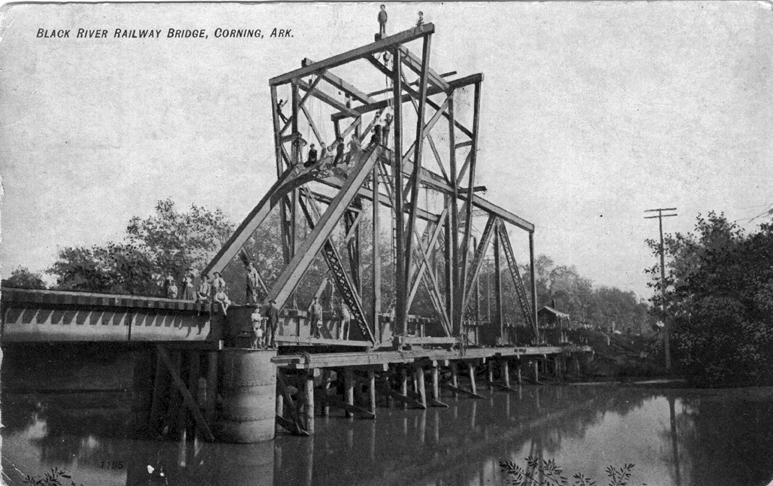
Black River Railroad Bridge, Corning, AR.
“This is a scene on Black River new bridge.
This is low water. It gits
all over the bottoms sometimes twenty five miles wide.
Good bye from one that hasn’t forgot you.
M. F. S."
Postmarked “Corning, ARK. June 26, 1908” “to F. P. Milligan, Maysvill,
ARK, from MFS.” (Corning Library).
From
the Clay County Courier:
"Tommie
Russell brought by a section from the September 17, 1970 issue of The Courier,
which shows [sic] picture of the Railroad [sic] bridge over Black River, taken
in 1910.
"Accompanying
the picture was [sic] article written by the late J. M. Oliver, Jr., who worked
for several years gathering up old pictures and writing stories in preparation
for Corning's 1973 Centennial Celebration. The article, which we also
found interesting, is being reprinted for the enjoyment of Courier readers who
may be interested in area history:
"
'Anxious to get their railroad, the Cairo and Fulton, into operation in 1872,
after the delay caused by the Civil War, bridges across the smaller Black and
Little Red Rivers were being rushed to completion in 1872 and the line was
opened from St. Louis to Little Rock in March 1875... the longer bridges
at Newport, over White River and across the Arkansas River at Little Rock were
not completed until late in 1873 and the passengers ferried across the two
streams to reach the terminal, shuttle trains operated between the two ferries.
"
'By 1910 the increased weight of the new locomotives and the increased size of
the boxcar and longer trains made the early bridges obsolete and the Summer of
1910 found a bridge building gang camped on the banks to rebuild. Piling
had to be driven deeper and heavier iron work at the top with draw bridge at the
near end since the river was still considered navigable and the river had to be
open to boats to the Arkansas-Missouri state line.
"
'Corning citizens enjoyed strolling down to the bridge to check on progress and
quite naturally, L. D. Oaks, the photographer of the local scene, showed up one
day with his camera. The bridge crew posed from the topmost parts of the
structure and the local viewers contended themselves by posing in the safer
position on the tracks. No identifications are possible at this late date
but the ubiquitous lad who always made an L. D. Oaks scene is perched in
barefoot splendor in the foreground.' The picture is from the Anna Lindsey
collection and was among hundreds of pictures that made an appearance locally in
the years leading up to our Centennial."
Submitted
by Danny Moore
